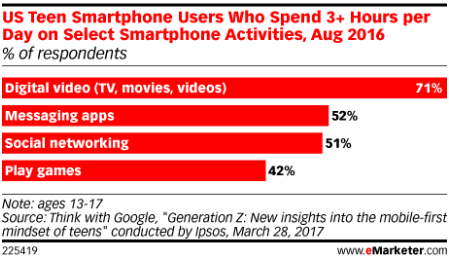Media
Teenagers Can’t Get Enough Mobile Video
I have a pair of 13-year-old cousins who come over my childhood home every year for the holidays. When they were younger, their parents often harped on their impish outdoor behavior: “Put down that tree branch!” “Get out of the mud!” Eventually, they outgrew their old vices and replaced them with something more modern: excessive cell phone usage.
While less destructive, their constant fixation on the small screens doesn’t make mom and dad any happier. According to a Think with Google study conducted by Ipsos, my cousins’ behavior is par for the teenage course.

The fact that 71 percent of 13-17 year-old smartphone users spend more than three hours a day watching mobile video is mind-boggling. But really, their habits might not be so different from the excessive viewing of previous generations; they’ve just switched the medium from cable TV to streaming services. A poll by Defy Media found that consumers aged 13-24 watch 12.1 hours of video per week on YouTube and other free online sources, and another 8.8 hours on paid-subscription platforms like Netflix. Television, at 8.2 hours per week, now sits in third.
“While millennials were mobile pioneers, teens are mobile natives,” Google writes in the study. Unlike previous generations that had to learn how to use new digital products later in life, advanced technology has been embedded in teenagers’ lives since birth. Today’s teens receive cell phones at 12. Those in the 18-24 segment reported first getting a phone at 16, and 25-34 year-olds said they had to wait until they were 20.
This tech acumen pervades the rest of their lives as well. Not only did half of the teens surveyed admit to spending over three hours a day on messaging apps, but they’re choosing to text in place of face-to-face interaction. Thirty-eight percent favor texting as their primary means of communication, while only 15 percent prefer talking in-person. While it’s easy to assume convenience is a contributing factor, proximity doesn’t always matter. Three in 10 acknowledge that they text people who are physically close to them.
Older generations may take such behavior as antisocial and impolite, but teens don’t mean it that way. They’re just communicating in the manner they know best. Next time I find my cousins buried in their phones, I’ll know better. If I want to hear about how school is going, I’ll send a group chat.
Image by Raetorian Photo / GettyGet better at your job right now.
Read our monthly newsletter to master content marketing. It’s made for marketers, creators, and everyone in between.




